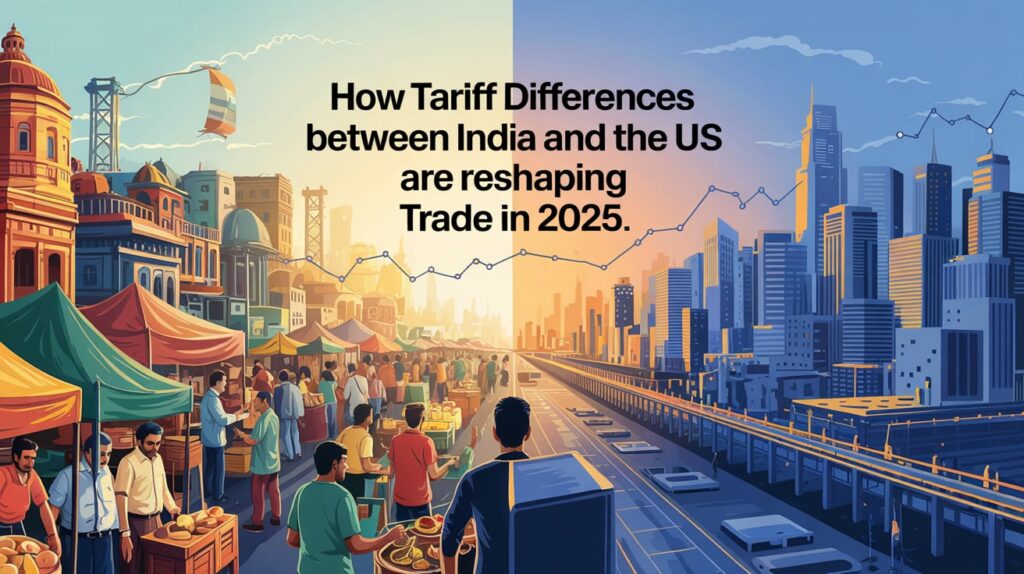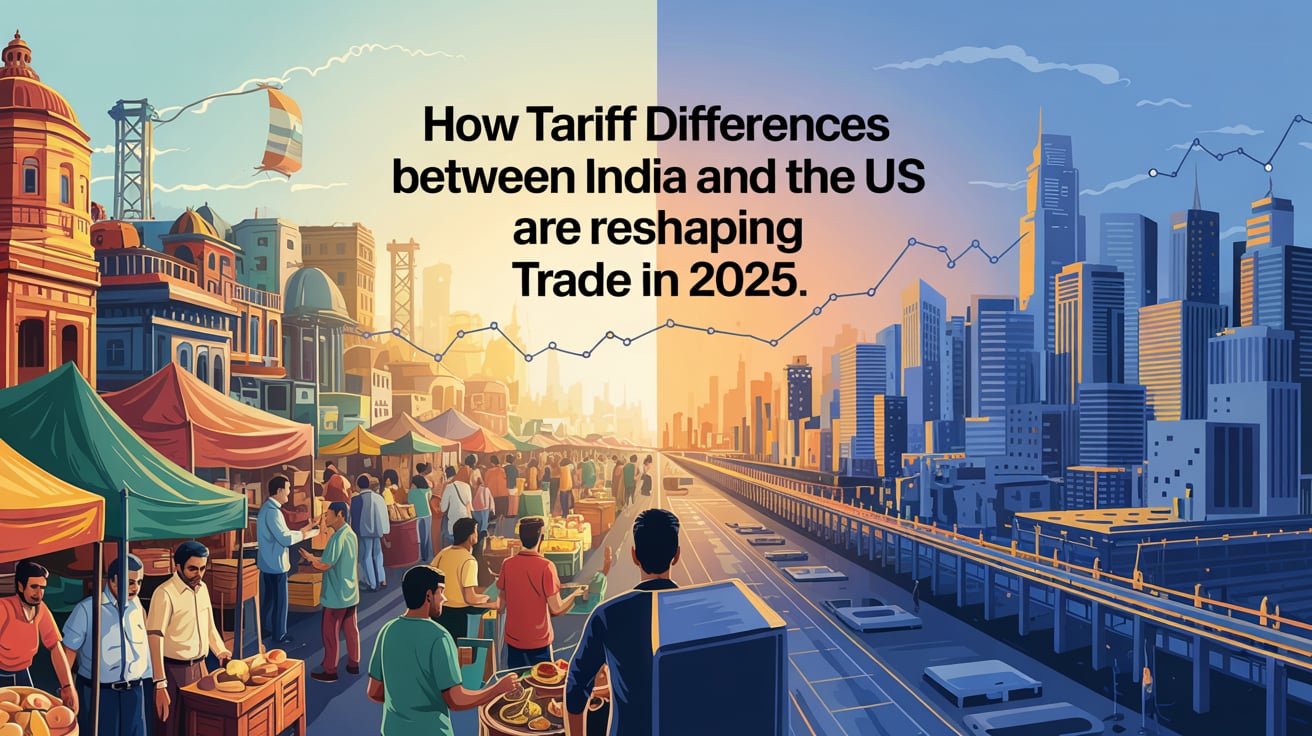Introduction
In today’s interconnected global economy, tariffs play a pivotal role in shaping trade relationships between nations. The relationship between India and the United States is no exception. As we enter 2025, understanding the tariff differences between these two economic powerhouses becomes crucial for businesses, policymakers, and investors alike. This article delves deep into the nuances of these tariff gaps, focusing on both agricultural and non-agricultural sectors, and explores their implications for trade, investment, and market opportunities.
Table of Contents
- Understanding Tariffs and Their Role in Trade
- Tariff Differences Between India and the US: A Comparative Analysis
- 2.1 Agriculture Sector
- 2.2 Non-Agricultural Sector
- Impact on Key Industries
- 3.1 Agriculture: Opportunities and Challenges
- 3.2 Manufacturing: Leveraging Tariff Gaps
- 3.3 Pharmaceuticals: Navigating Complexities
- Strategies for Businesses
- 4.1 Exporters: Maximizing Tariff Benefits
- 4.2 Importers: Mitigating Tariff Risks
- Policy Implications and Future Outlook
- Conclusion: Seizing Opportunities Amidst Tariff Dynamics
1. Understanding Tariffs and Their Role in Trade
Tariffs are essentially taxes imposed by a government on imported goods. They serve multiple purposes:
- Protecting Domestic Industries: By making imported goods more expensive, tariffs shield local producers from foreign competition.
- Generating Revenue: Governments use tariffs as a source of income.
- Addressing Trade Imbalances: Tariffs can be used to counteract unfair trade practices or imbalances.
However, tariffs also have downsides:
- Increased Costs for Consumers: Higher tariffs lead to higher prices for imported goods.
- Retaliatory Measures: High tariffs can trigger retaliatory actions from trading partners, leading to trade wars.
- Reduced Economic Efficiency: Tariffs can distort markets and reduce overall economic efficiency.
In the context of India and the US, understanding these dynamics is critical, especially as both countries seek to strengthen their economic ties while protecting their respective industries.

2. Tariff Differences Between India and the US: A Comparative Analysis
The data provided offers a comprehensive look at the tariff gap between India and the US across various sectors. Let’s break it down:
2.1 Agriculture Sector
| Product Category | Export to India ($ mn) | Import from India ($ mn) | Tariff Gap (%) |
|---|---|---|---|
| Alcohol, wines etc | 452.21 | 19.2 | 122.1 |
| Dairy products | 2.43 | 181.49 | 38.23 |
| Fish, meat, frozen, processed | 28.51 | 2586.96 | 27.83 |
| Live animals, products | 16.02 | 10.31 | 27.75 |
| Processed food, sugar, cocoa, preparations | 120.47 | 1038.66 | 24.99 |
| Edible oils | 45.19 | 199.75 | 10.67 |
| Cereals, vegetable, fruits, spices | 1275.13 | 1909.88 | 5.72 |
| Tobacco, cigarettes, products | 1.5 | 94.62 | -168.15 |
Key Observations:
- Alcohol and Dairy Products: India imposes significantly higher tariffs on alcohol and dairy imports compared to what it exports to the US. This protects domestic industries but limits trade opportunities.
- Fish and Meat: The high import tariffs on fish and meat suggest India’s focus on safeguarding its domestic livestock sector.
- Cereals and Spices: Lower tariff gaps in cereals and spices indicate relatively balanced trade in these categories.
- Tobacco Products: Negative tariff gaps (e.g., tobacco) highlight areas where India may be overtaxing imports, potentially stifling trade.
2.2 Non-Agricultural Sector
| Product Category | Export to India ($ mn) | Import from India ($ mn) | Tariff Gap (%) |
|---|---|---|---|
| Automobiles, bikes, parts | 419.53 | 2804.93 | 23.1 |
| Shoes, footwear, parts | 3.38 | 457.66 | 15.56 |
| Diamonds, gold, silver and products | 1916.18 | 11884.16 | 13.32 |
| Pharmaceuticals | 567.64 | 12726.6 | 10.9 |
| Artificial flowers, umbrella, headgears | 0.76 | 34.94 | 10.29 |
| Clock, medical, furniture, toys, work of art | 1745.99 | 2861.2 | 8.9 |
| Ceramic products, glass and stone, cement products | 163.85 | 1716.72 | 8.27 |
| Electrical, telecom, and electronics products | 1343.62 | 14395.25 | 7.24 |
| Textiles, fabric, yarn, fibre, carpets | 336.32 | 2768.75 | 6.59 |
| Chemicals except pharma | 2947.9 | 5713.2 | 6.05 |
| Plastics, articles | 1408.52 | 1358.72 | 5.56 |
| All machinery, boilers, turbines, computers, parts | 2848.07 | 7103.95 | 5.29 |
| Products of iron, steel | 1072.08 | 3322.54 | 3.63 |
Key Observations:
- Automobiles and Electronics: India imposes higher tariffs on automobile and electronic imports, reflecting its efforts to boost domestic manufacturing.
- Diamonds and Gold: Despite high export values, India maintains significant import tariffs on diamonds and gold, likely due to strategic resource management.
- Textiles and Chemicals: Lower tariff gaps in textiles and chemicals suggest relatively open trade policies in these sectors.
- Iron and Steel: The low tariff gap in iron and steel indicates a balanced approach to trade in this category.
3. Impact on Key Industries
3.1 Agriculture: Opportunities and Challenges
India’s high tariffs on certain agricultural imports, such as alcohol and dairy products, provide a competitive edge to domestic producers. However, this protectionism can limit access to cheaper inputs and technologies from the US. For instance, Indian dairy farmers may struggle to compete globally if they rely solely on protected domestic markets.
On the flip side, India’s lower tariffs on cereals and spices create opportunities for US exporters. By leveraging these gaps, American companies can penetrate the Indian market with cost-effective products.
3.2 Manufacturing: Leveraging Tariff Gaps
India’s high tariffs on automobiles, electronics, and machinery reflect its ambition to build a robust domestic manufacturing base. While this protects local industries, it also creates challenges for US exporters looking to sell high-value products in India.
Conversely, Indian manufacturers can exploit these tariff gaps by exporting value-added products to the US, where demand for affordable goods remains strong. For example, Indian textile manufacturers can capitalize on lower tariffs to gain a foothold in the US market.
3.3 Pharmaceuticals: Navigating Complexities
The pharmaceutical sector presents a unique challenge. India is a global leader in generic drug production, but US tariffs on pharmaceutical imports can hinder its exports. At the same time, India’s lower tariffs on pharmaceutical imports allow it to source advanced drugs and technologies from the US, enhancing its healthcare infrastructure.
Businesses in this sector must navigate these complexities carefully, balancing cost considerations with regulatory requirements.
4. Strategies for Businesses
4.1 Exporters: Maximizing Tariff Benefits
- Identify Low-Tariff Sectors: Focus on sectors where India imposes minimal tariffs, such as textiles, chemicals, and plastics. These offer lucrative opportunities for US exporters.
- Invest in Local Partnerships: Collaborate with Indian businesses to understand market dynamics and comply with local regulations.
- Leverage Free Trade Agreements (FTAs): Explore existing FTAs between India and the US to reduce or eliminate tariffs on specific products.
4.2 Importers: Mitigating Tariff Risks
- Source Alternatives: If tariffs on certain products are prohibitively high, explore alternative sourcing options or consider importing similar products from other countries.
- Negotiate Tariff Exemptions: Work with governments to secure tariff exemptions or reductions for critical imports.
- Optimize Supply Chains: Streamline logistics to minimize costs and offset the impact of high tariffs.
5. Policy Implications and Future Outlook
The tariff landscape between India and the US is dynamic and influenced by geopolitical factors, economic priorities, and bilateral agreements. Here are some key takeaways:
- Bilateral Trade Talks: Both countries are engaged in ongoing negotiations to harmonize tariffs and expand trade. Any progress in these talks could significantly alter the current tariff structure.
- Focus on Digital Trade: As digital commerce grows, both nations are exploring ways to reduce barriers in services and e-commerce, which could mitigate the impact of traditional tariffs.
- Sustainability Initiatives: Increasing emphasis on sustainability and green technologies may lead to new tariff policies that favor eco-friendly products.
6. Conclusion: Seizing Opportunities Amidst Tariff Dynamics
Tariff differences between India and the US are not just numerical disparities; they represent strategic choices that shape trade, investment, and market access. By understanding these gaps, businesses can identify opportunities to grow and thrive in this evolving landscape.
For exporters, focusing on low-tariff sectors and leveraging partnerships can unlock new markets. For importers, mitigating risks through alternative sourcing and policy advocacy is crucial. Ultimately, staying informed about tariff trends and adapting strategies accordingly will be key to success in the global marketplace.
Final Thoughts
As India and the US continue to refine their trade policies, the opportunities and challenges presented by tariff differences will evolve. By navigating these dynamics intelligently, businesses can position themselves to capitalize on emerging trends and drive growth in 2024 and beyond.
Call to Action
Stay tuned for our next article, where we’ll explore how technology and innovation are reshaping global trade strategies. In the meantime, feel free to share your thoughts or questions in the comments below!
- World Trade Organization (WTO)
- Indian Ministry of Commerce and Industry
- US International Trade Commission




